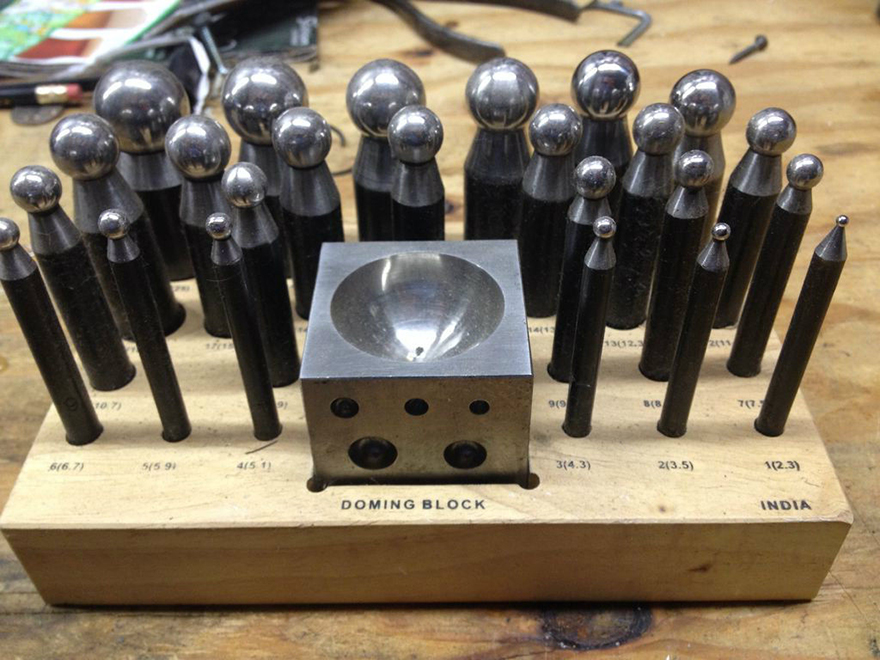More on 3D Coins, and an Illegal DIY Production Method: The Doming Block
 Image via Seadraggin
Image via SeadragginLove it or hate it, the U.S. Mint's forthcoming 3D coin seems to be capturing people's imaginations. And while we previously looked at the cool production methods behind making coins here and here, reader Dan pointed out that we were remiss in not mentioning Don Everhart, the U.S. Mint Sculptor responsible for turning Cassie McDonald's baseball design into reality:
 Images via Coin News
Images via Coin NewsNumismatic website Coin News has a feature up on Everhart, where you can see shots of him sculpting as well as the CNC mill they use to cut the steel blanks.
As for the rest of us who don't have access to such technology, there are DIY ways to make domed coins: Hobbyists and tinkerers use something called a doming block to hammer coins into sweet bowl shapes. Check out how the woman behind the Epbot "Geekery, Girliness, & Goofing Off" blog turned these pennies into buttons:
 Images via Epbot
Images via EpbotA jewelry-making blog called Rings & Things provides more details in their "How to dap and dome metal jewelry" article, where they show you this sweet necklace made from a Canadian penny:
 Images via Rings & Things
Images via Rings & ThingsThis guy banged quarters into domes to pimp his yo-yo designs:
 Images via Coin Talk
Images via Coin TalkAnd Instructables user Seadraggin runs down, step by step, how he turns quarters into snap buttons:

[images via Seadraggin
It's on that last Instructable's comments section that a party-pooper points out the illegality (at least in the U.S.) of all this DIY fun:
Defacement of currency is a violation of Title 18, Section 333 of the United States Code. Under this provision, currency defacement is generally defined as follows: Whoever mutilates, cuts, disfigures, perforates, unites or cements together, or does any other thing to any bank bill, draft, note, or other evidence of debt issued by any national banking association, Federal Reserve Bank, or Federal Reserve System, with intent to render such item(s) unfit to be reissued, shall be fined under this title or imprisoned not more than six months, or both.
-
oFavorite This
-
Q5Comment
K
{Welcome
Create a Core77 Account
Already have an account? Sign In
By creating a Core77 account you confirm that you accept the Terms of Use
K
Reset Password
Please enter your email and we will send an email to reset your password.


Comments
The statute you cite only applies to bank notes (paper money). The Federal Reserve issues banknotes while the US Mint issues coins.
I know this story is a year old, but I have to tell you that making jewelry out of coins is not illegal in the USA. It is only illegal if you change the coin and then try to market it as a coin. I called the Philadelphia mint and talked to a woman who said that also applies to paper money....
Typical government: create something that costs more to make than it is worth, then write a law to prevent people from capitalizing on the fiscal irresponsibility.
Read more: http://www.ehow.com/info_7849191_defacing-money.html#ixzz2wQoAMXUs
Federal statue 18 USC 331 states that "[w]hoever fraudulently alters, defaces, mutilates, impairs, diminishes, falsifies, scales, or lightens any of the coins coined at the mints of the United States ... shall be fined under this title or imprisoned not more than five years, or both." The key word in this statute is "fraudulently." To sustain a criminal prosecution for defacing a coin, the prosecutor must prove an intent to defraud. An example of defacing with the intent to defraud is removing precious metal from a coin or changing the denomination of a coin.
The Code of Federal Regulations (CFR) contains an obscure set of rules regarding nickels and pennies. Code 31 CFR 82.1 states, "Except as specifically authorized by the Secretary of the Treasury (or designee) or as otherwise provided in this part, no person shall export, melt, or treat: (a) Any 5-cent coin of the United States; or (b) Any 1-cent coin of the United States." However, the next section, 31 CFR 82.2, specifically allows that the "prohibition contained in §82.1 against the treatment of 5-cent coins and 1-cent coins shall not apply to the treatment of these coins for educational, amusement, novelty, jewelry, and similar purposes as long as ... the treatment makes it clear that such treatment is not intended as a means by which to profit solely from the value of the metal content of the coins." Read together, the defacement of coins for artistic and entertainment is not illegal as long as the intent is clear and the consumer is not misled.